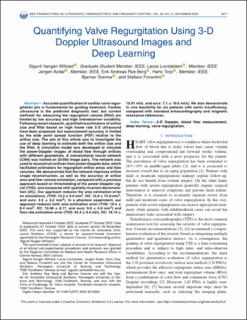| dc.contributor.author | Wifstad, Sigurd Vangen | |
| dc.contributor.author | Løvstakken, Lasse | |
| dc.contributor.author | Avdal, Jørgen | |
| dc.contributor.author | Berg, Erik Andreas Rye | |
| dc.contributor.author | Torp, Hans | |
| dc.contributor.author | Grenne, Bjørnar | |
| dc.contributor.author | Fiorentini, Stefano | |
| dc.date.accessioned | 2023-04-12T12:48:46Z | |
| dc.date.available | 2023-04-12T12:48:46Z | |
| dc.date.created | 2022-11-01T10:45:58Z | |
| dc.date.issued | 2022 | |
| dc.identifier.citation | IEEE Transactions on Ultrasonics, Ferroelectrics and Frequency Control. 2022, 69 (12), 3317-3326. | en_US |
| dc.identifier.issn | 0885-3010 | |
| dc.identifier.uri | https://hdl.handle.net/11250/3062697 | |
| dc.description.abstract | Accurate quantification of cardiac valve regurgitation jets is fundamental for guiding treatment. Cardiac ultrasound is the preferred diagnostic tool, but current methods for measuring the regurgitant volume are limited by low accuracy and high interobserver variability. Following recent research, quantitative estimators of orifice size and regurgitant volume based on high frame rate 3-D ultrasound have been proposed, but measurement accuracy limited by the wide point spread function relative to the orifice size. The aim of this paper was to investigate the use of deep learning to estimate both the orifice size and the regurgitant volume. A simulation model was developed to simulate the power-Doppler images of blood flow through orifices with different geometries. A convolutional neural network was trained on 30000 image pairs. The network was used to reconstruct orifices from power-Doppler data, which facilitated estimators for regurgitant orifice areas and flow volumes. We demonstrate that the network improves orifice shape reconstruction, as well as the accuracy of orifice area and flow volume estimation, compared to a previous approach based on thresholding of the power-Doppler signal (THD), and compared to spatially invariant deconvolution (DC). Our approach reduces area estimation error on simulations: (THD: 13.2 ± 9.9 mm2, DC: 12.8 ± 15.8 mm2, ours: 3.5 ± 3.2 mm2). In a phantom experiment, our approach reduces both area estimation error (THD: 10.4 ± 8.4 mm2, DC: 10.98 ± 8.17, ours: 9.9 ± 6.0 mm2), and flow rate estimation error (THD: 20.3 ± 9.9 ml/s, DC: 18.14 ± 13.01 ml/s, ours: 7.1 ± 10.6 ml/s). We also demonstrate in vivo feasibility for six patients with aortic insufficiency, compared with standard echocardiography and magnetic resonance references. | en_US |
| dc.description.abstract | Quantifying Valve Regurgitation Using 3-D Doppler Ultrasound Images and Deep Learning | en_US |
| dc.language.iso | eng | en_US |
| dc.publisher | IEEE | en_US |
| dc.rights | Navngivelse 4.0 Internasjonal | * |
| dc.rights.uri | http://creativecommons.org/licenses/by/4.0/deed.no | * |
| dc.title | Quantifying Valve Regurgitation Using 3-D Doppler Ultrasound Images and Deep Learning | en_US |
| dc.title.alternative | Quantifying Valve Regurgitation Using 3-D Doppler Ultrasound Images and Deep Learning | en_US |
| dc.type | Peer reviewed | en_US |
| dc.type | Journal article | en_US |
| dc.description.version | publishedVersion | en_US |
| dc.source.pagenumber | 3317-3326 | en_US |
| dc.source.volume | 69 | en_US |
| dc.source.journal | IEEE Transactions on Ultrasonics, Ferroelectrics and Frequency Control | en_US |
| dc.source.issue | 12 | en_US |
| dc.identifier.doi | 10.1109/TUFFC.2022.3218281 | |
| dc.identifier.cristin | 2067224 | |
| dc.relation.project | Norges forskningsråd: 237887 | en_US |
| cristin.ispublished | true | |
| cristin.fulltext | original | |
| cristin.qualitycode | 1 | |

